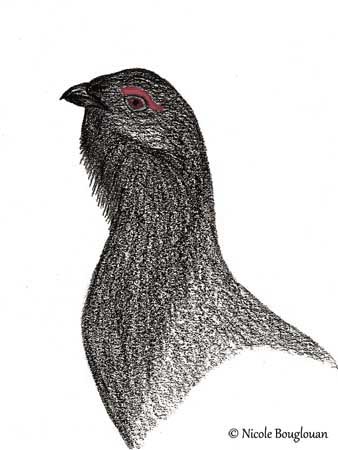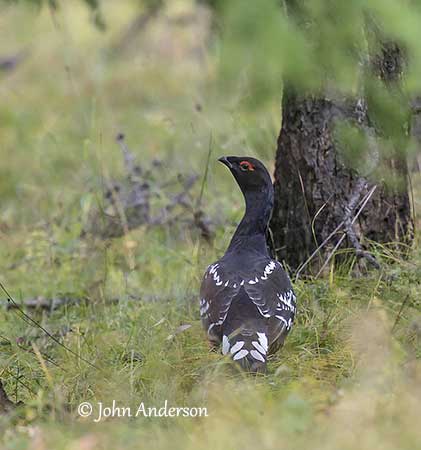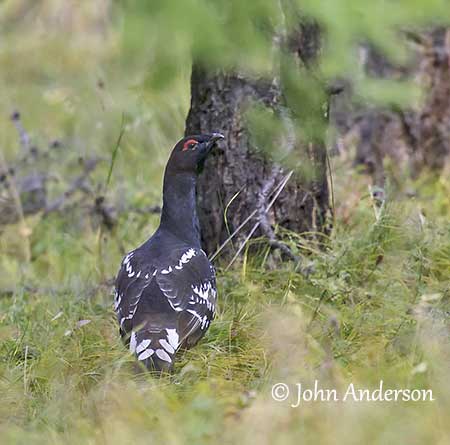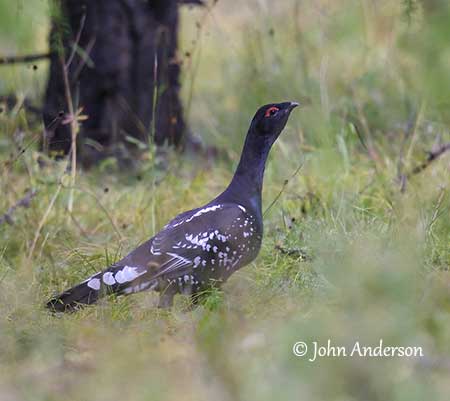
Fr: Tétras à bec noir
Ang: Black-billed Capercaillie
All: Steinauerhuhn
Esp: Urogallo Piquinegro
Ita: Gallo cedrone becconero
Nd: Rotsauerhoen
Sd: svartnäbbad tjäder
Photographer:
John Anderson
John Anderson Photo Galleries
Text and illustration by Nicole Bouglouan
Sources:
HANDBOOK OF THE BIRDS OF THE WORLD Vol 2 by Josep del Hoyo-Andrew Elliot-Jordi Sargatal - Lynx Edicions - ISBN: 8487334156
Hennache, A. & Ottaviani, M. (2005). Monographie des faisans, volume 1. Edition W.P.A. France, Clères, France. ISBN: 2-9512467-1-4
Hennache, A. & Ottaviani, M. (2006). Monographie des faisans, volume 2. Edition W.P.A. France, Clères, France.ISBN: 2-9512467-2-2
Les auteurs renoncent à leurs droits d'auteurs pour que la vente de cet ouvrage, publié par la World Pheasant Association, soit destinée à soutenir des projets de conservation.
Ecology and behaviour of the Black-billed Capercaillie in the Khentej Mountains, Mongolia
The official Polar Conservation Organisation website
Winter Habitat Segregation in the Sexually Dimorphic Black-Billed Capercaillie
The Arctic Guide: Wildlife of the Far North Par Sharon Chester
Wikipedia, the free encyclopaedia
Black-billed Capercaillie
Tetrao urogalloides
Galliformes Order – Tetraonidae Family
INTRODUCTION:
The Black-billed Capercaillie is closely related to the Western Capercaillie (T. urogallus). Their ranges overlap over a wide area of the Yenisey Basin, and interbreeding often results in hybrids in limited areas.
Capercaillies are forest dwellers of considerable size, and both species were probably separated during the Ice Ages. The Black-billed Capercaillie is sedentary in E Russia, in parts of N Mongolia and China. It frequents montane forests and taiga.
At the beginning of the breeding season, several males gather at display grounds, calling loudly while fanning out their tail feathers. These displays are used to attract the females visiting the leks.
The population of the Black-billed Capercaillie is declining, due to overhunting and natural fluctuations. Natural predation by red fox, hawks and martens has not very significant impact on numbers.


DESCRIPTION OF THE BIRD:
Biometrics:
Length: M: 89-97 cm – F: 69-75 cm
Wingspan: 75-115 cm
Weight: M: 3350-4580 g – F: 1700-2200 g
The Black-billed Capercaillie adult male is slightly smaller than the Western Capercaillie. It has black plumage overall, although several large, white spots contrast strongly on the wings and at tips of the uppertail-coverts. We can see conspicuous white patches on scapulars too.
The plumage may appear shiny black, but when the bird remains in the darkness of the forest with folded wings and tail, this pattern is mostly hidden or not conspicuous.
The bill is black, giving the species its name. The dark eyes have red combs above that develop especially during the breeding season. They are conspicuous during the displays. The strong, dark legs have feathered tarsi and robust feet.
The adult female resembles T. urogallus, but she is darker and more heavily marked on the upper breast. The white pattern on both wing-coverts and secondaries is formed by large terminal bands to feathers.
The bill is blackish. The eyes are dark brown with much smaller red combs than male, often hidden by the feathers. The brownish tarsi are feathered and the dark grey toes are often partially covered by the long feathers of the tarsi.
The young bird has almost hidden combs, but the plumage maturation is poorly known.
SUBSPECIES AND RANGE:
The Black-billed Capercaillie has two or three subspecies, depending on the authors.
T.u. urogalloides is found in E Siberia, from lower R Yenisey to upper R Anadyr, E to Transbaikalia, NE China (Mandchuria), Sikhote-Alin Mts, and Sakhalin Island.
T.u. kamtschaticus is found in Kamchatka Peninsula.
Both sexes are smaller than nominate. It shows more numerous white and larger spots. Males are less glossy and mostly dark grey.
T.u. stegmanni is found in L. Baikal area, Sayan Mts and N Mongolia.
It is usually slimmer than nominate, with larger tail. It has larger white spots on undertail-coverts.
The race “stegmanni” is included in the nominate race by some authors.
HABITAT:
The Black-billed Capercaillie frequents forests with Siberian larch, both in plains and mountains, from wooded tundra in N to woody steppes in S Transbaikalia.
However, according to the range, it also frequents pine, cedar or mixed deciduous/coniferous forests.
During winter, the males or cocks can be found in the lower foothills with scattered stands of pines and birches. The larger males create and maintain “gardens” of dwarf larch trees. These areas provide them more food. Actually, the males trim seasonally numerous young larches by suppressing the vertical growths, involving a transformation into a dwarf form of larch.
The females or hens usually spend the winter in flocks at higher elevations in mountains. They often stay in younger and dense larch forests that are less productive habitats. They avoid the “gardens” to minimize the risk of predation.
CALLS ANS SONGS: SOUNDS BY XENO-CANTO
The Black-billed Capercaillie male produces series of “castanet-like” sounds. This song is a continuous clapping with an accelerating phrase “tack-tack-tack…” that can be heard at some distance (1-1,5 km) depending on weather conditions.
Other noises similar to drumming sounds are produced by the wings while the male jumps during the displays. These strong sounds attract the females.

BEHAVIOUR IN THE WILD:
The Black-billed Capercaillie, like most Tetraonidae, has vegetarian diet. It feeds largely on larch buds and shoots, and also pine and fir needles, birch catkins and buds, and fruits of Rosa acicularis, all taken during the winter.
During spring and autumn, it feeds on berries and leaves of several plant species, and some caterpillars, midges and ant eggs.
Male and female feed in trees, but the females feed less often on the ground than males. They feed in the crown of larch trees, and the males can be seen on the ground in and around their leks. They often favour the edges of the larch forest where they can feed on freshly sprouting grass and other plants.
They forage in flocks during winter, but the males are mostly in small groups of 2-4 birds, whereas the females are more numerous, between 2 and 14 individuals.
At the beginning of the breeding season, (mid-April), the males form leks or arenas in mature forest where they display to attract females. The lek is established in a flat area, usually at a short distance of the feeding areas. The females visit these territories and chose a mate.
The males start displaying in the early morning, coming from their resting trees. They fly down to the ground and sing continuously for several hours, with some short pauses.
Adapted postures enhance the black bill, the red eye combs, the white patches of wing-coverts and tail, and the typical shape of the expanded breast. They perform flutter-jumps (2-10 metres high) to attract females, accompanied by loud wing-drumming sounds while the bird is rising and during the landing phase.
Several females visit the lek and approach the courting males. When a female is ready for copulation, she crouches down and touches the ground with her wings.
There is no aggression between females, whereas males fight at territory borders. They use both wings and bill, and some fights may involve serious injuries. However, interactions are usually reduced to threatening with both males walking side to side along the territory border, then facing each other and bowing.
The female performs alone all the nesting duties, incubates and rears the brood.

The Black-billed Capercaillie is probably sedentary except for some altitudinal movements in Kamchatka as the females winter at higher elevations than males. The males may move locally, according to food resources.
Like most Galliformes, the Black-billed Capercaillie starts the flight with strong, noisy take-off, and once in the air, it performs series of rapid wingbeats interspersed with fast glides on down-curved wings.
REPRODUCTION OF THIS SPECIES:
The breeding season starts in mid-April, with the laying in May-June.
The female leaves the lek after the copulation. She selects the nest-site and builds the nest on the ground, a shallow depression lined with needles, moss, grass and feathers. It is placed below low branches, fallen log or tree.
She lays 6-7 eggs and incubates during 20-25 days. She remains motionless on the eggs, to take advantage of her cryptic plumage coloration. At this period, she is vulnerable to predation by mammals and birds, involving sometimes nest failure.
At hatching, the downy chicks have rufous crown patch. They have more rufous, less streaked back then the young T. urogallus. They can follow the female very soon, and are able to fly, or at least to reach the high branches of a tree for perching, 2-3 weeks after hatching.
PROTECTION / THREATS / STATUS:
The Black-billed Capercaillie’s population is declining due to human disturbance through road construction, allowing accessibility of habitats. Natural fluctuations, predation and overhunting threaten the population too.
An estimate gives less than 100 breeding pairs in China, and 100,000/1 million breeding pairs in Russia.
But currently, the Black-billed Capercaillie is evaluated as Least Concern.